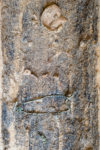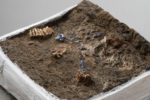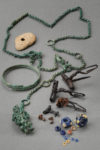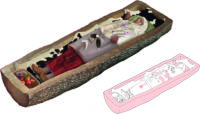 In March of 2017, municipal archaeologists unearthed the grave of a Celtic woman at the Kern school complex in Zurich where a new gym was being built. The tomb was found in front of the west façade of the school building, just a few feet from where the foundation of the schoolhouse had been constructed in 1862.
In March of 2017, municipal archaeologists unearthed the grave of a Celtic woman at the Kern school complex in Zurich where a new gym was being built. The tomb was found in front of the west façade of the school building, just a few feet from where the foundation of the schoolhouse had been constructed in 1862.
 While the neighborhood is archaeologically sensitive and graves have been found during earlier bouts of construction, most of them dated to the early Middle Ages. It is extremely rare to find a prehistoric grave in a highly developed urban area, and even more rare to find one laden with rich grave goods as this one was. Only one other grave of this date has been unearthed in this area before. It was found in 1903 and held the remains of a Celtic man buried with a sword, shield and lance of high quality. It was located about 80 meters (262 feet) away from the recent find.
While the neighborhood is archaeologically sensitive and graves have been found during earlier bouts of construction, most of them dated to the early Middle Ages. It is extremely rare to find a prehistoric grave in a highly developed urban area, and even more rare to find one laden with rich grave goods as this one was. Only one other grave of this date has been unearthed in this area before. It was found in 1903 and held the remains of a Celtic man buried with a sword, shield and lance of high quality. It was located about 80 meters (262 feet) away from the recent find.
 The grave discovered in 2017 held the skeletal remains of a woman who had been buried in a hollowed out tree trunk. Only the shape of it was visible in the grave, but it was confirmed by the presence of wood residues. The bones were fragmentary. The individual was identified as a woman by the clothing and
The grave discovered in 2017 held the skeletal remains of a woman who had been buried in a hollowed out tree trunk. Only the shape of it was visible in the grave, but it was confirmed by the presence of wood residues. The bones were fragmentary. The individual was identified as a woman by the clothing and  jewelry interred with her. She was adorned with a delicate bronze belt chain with pendants and a hook closure. She also wore bronze bracelets and a rich necklace strung with beads of amber, blue and yellow glass with two brooches as fasteners. Her robe was closed with several iron fibulae. The objects date to the grave to 250-200 B.C., the early Iron Age.
jewelry interred with her. She was adorned with a delicate bronze belt chain with pendants and a hook closure. She also wore bronze bracelets and a rich necklace strung with beads of amber, blue and yellow glass with two brooches as fasteners. Her robe was closed with several iron fibulae. The objects date to the grave to 250-200 B.C., the early Iron Age.
 Sections of the grave were removed en bloc to be excavated and studied further in laboratory conditions, with particular focus on textile remnants. Zurich’s archaeology department has been studying the finds ever since, and has now released the results of their examination.
Sections of the grave were removed en bloc to be excavated and studied further in laboratory conditions, with particular focus on textile remnants. Zurich’s archaeology department has been studying the finds ever since, and has now released the results of their examination.
Stable isotope analysis of her bones revealed that she was a local woman, raised in Zurich, probably in the Limmat Valley. Examination of her bones and teeth found she was about 40 years old when she died and  had not performed a great deal of physical labour. Tooth decay points to her having enjoyed a diet high in starchy or sweet foods. Fragments of textiles, fur and leather found in the soil indicate she was buried in a dress made of fine sheep’s wool, then wrapped in a woolen cloth and a coat made of sheepskin.
had not performed a great deal of physical labour. Tooth decay points to her having enjoyed a diet high in starchy or sweet foods. Fragments of textiles, fur and leather found in the soil indicate she was buried in a dress made of fine sheep’s wool, then wrapped in a woolen cloth and a coat made of sheepskin.
The newly discovered grave complements today’s picture of the Celtic settlement history in the Zurich area. For a long time Zurich was considered to have been founded by Roman. Archaeological excavations and evaluations of recent years, however, provided evidence for a town-like settlement of the Celts on the Lindenhof hill already from the first half of the 1st century B.C., at least half a century before the arrival of the Romans. This early city then merged seamlessly with the Roman “Turicum”. The two tombs at the Kern school complex are around 100 years older than this first settlement on the Lindenhof and probably belonged to one of several smaller settlements around Zurich, probably in the Sihlfeld, but so far still undiscovered.
Truly, that’s a ‘Swiss Army Knife’ of a posh bronze belt :love:
Have for instance a look at ‘190507_mm_04_Lebensbilder.jpg‘ (from the 2nd URL). Obviously, the Swiss girls hooked the ring that corresponded to their individual belly size(s), and then –in order to close the belt– hooked the ringed closure to the other hook, i.e. to tighten (i.e. tension) their belts. Once put on, all kinds of devices, blades, tools and purses could be attached to those rings.
Even cooler it would be to connect a Swiss Army Knife to one of those belts. Certainly, the amber beads were harvested in the Baltic Sea. Also, I know that metal ‘bronzes’ (e.g. gold) can sometimes be analyzed. But would it be possible to determine, where the tin in a ‘tin bronze’ would have been mined? There is no tin in Switzerland, or is there?
By the way, did you know that the pocket knife is in fact a Celtic invention? There were pocket knives found in what today is Austria that were made a few centuries before our girl was laid in her tree coffin, i.e. laid into her coffin (*sigh* :confused: I think, you know what I mean).
Perhaps the precursor to the Swiss Army knife is also the original ‘chatelaine’, a similar design which every married woman used to hold the keys, and other items needed to maintain a well-ordered household.
Indeed Emily, I personally reckon that thing would count as ‘chatelaine’.
Maybe a little bit like here (OK, a bit more recent, but with blades).
As far as the blue and yellow glass is concerned, there is (from the 2nd century BC) the tiny glass dog (blue, yellow and white) from Wallertheim (‘Wallertheim Glass Doggy’, Inv. Nr. V 56/94, 2.1cm x 1.6 cm, i.e. 0.83inch x 0.63inch, burials 30/31).
Maybe, therefore, the glass is Rhenish (..or the dog Swiss 😉 ).
I didn’t realize Holsteins went back that far. The reconstruction graphic is superb. Thanks, LD, as always for sharing the knowledge. The deceased clearly enjoyed “starchy or sweet foods” in life, evidenced by her after world snack of fruit and bread.
A chatelaine with blades
:hattip: